In my 15 minutes of focus, I noticed that my sit spot was a lot quieter today than it is normally. I heard less birds singing, and saw less activity overall. The only thing I saw more of than usual was this one dragonfly that I typically see (at least I assume it’s just the one). While I was logging those fifteen minutes after tuning in for them, I felt like I missed a lot of its activity- when I stopped to log, it was hovering right in front of me over the stream bed, and when I looked up, he had disappeared.
As far as my three followed objects go, the reed-like plant I was watching that got removed a couple weeks ago is still missing, and some dandelions and other weeds are coming up instead. The turkey tail fungus I’m watching appears to be darker, and have more cracks along its surface, and it’s started to have this sort of green growth around it’s edges, that I assume is some kind of mildew. The calico aster I’ve been watching in addition to the reed like plant (since I assume it’s out of the game for the semester) is losing petals and drooping more than I observed last time. But other than that, the most notable change I’ve witnessed is in the orange jewels- with the seasons changing, I notice it shrinking back and yellowing more every time I go. This time only a few areas were even still visible.
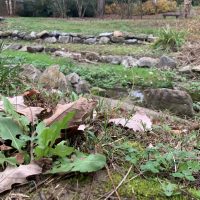
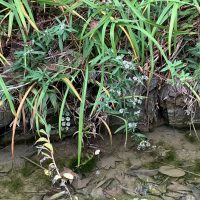
Here are the orange jewels and turkey tail fungus on my first visit to my sit spot, and them today.
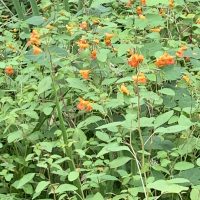
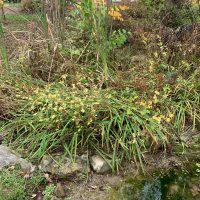

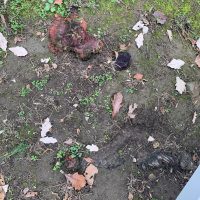
Naming some of the species that I see in my sit spot has changed how I feel about them. This isn’t really true for eastern gray squirrels, probably because I see them every day, but for calico aster and stream striders, this is absolutely true. Knowing the name for calico aster is just nice, and makes me feel like I could recognize it more effectively in other places. Naming stream striders and doing that little bit of research about them has really improved my overall perspective about them though- I used to really hate them because their erratic movement often disrupted the water’s surface and my view of the stream bed. But now that I know that they eat mosquito larvae, the more the merrier!
For my 1 square meter plot, I chose an area of the stream to the direct North of the bench and the rocks between the stream and me. I noted that the visible areas of stream bed here are made up of about 45% algae, 50% leaves (of all kinds), and about 5% silt at the moment. Decomposition is apparent in this area of the stream, as all of the leaves are a pretty uniform brown color, and any that still appear to be yellow or red in some areas are fading. There were never really NO stream striders in the square throughout the 15 minutes. At fewest, there were two. But seeing them all together in the square helped me notice how little variation there is between them. The most notable difference I saw was in both body size and overall size. All of them had four legs, thin and dark linear bodies that hovered above the stream, and blueish metallic stripes going along the length of their bodies on either side. But some had smaller bodies than others but took up the same amount space on average, and some were just flat out smaller than others. I also noticed what I assume to be the one dragonfly I normally see doing laps up and down the stream bed, and some small wolf or dock spiders on the rocks in front of me.

That is so cool that you normally see a dragonfly.
Nice blog Cheyenne – the water striders actually have 6 legs but they only ride around on 4 of them. The projects in front are actually their remaining pair of legs….